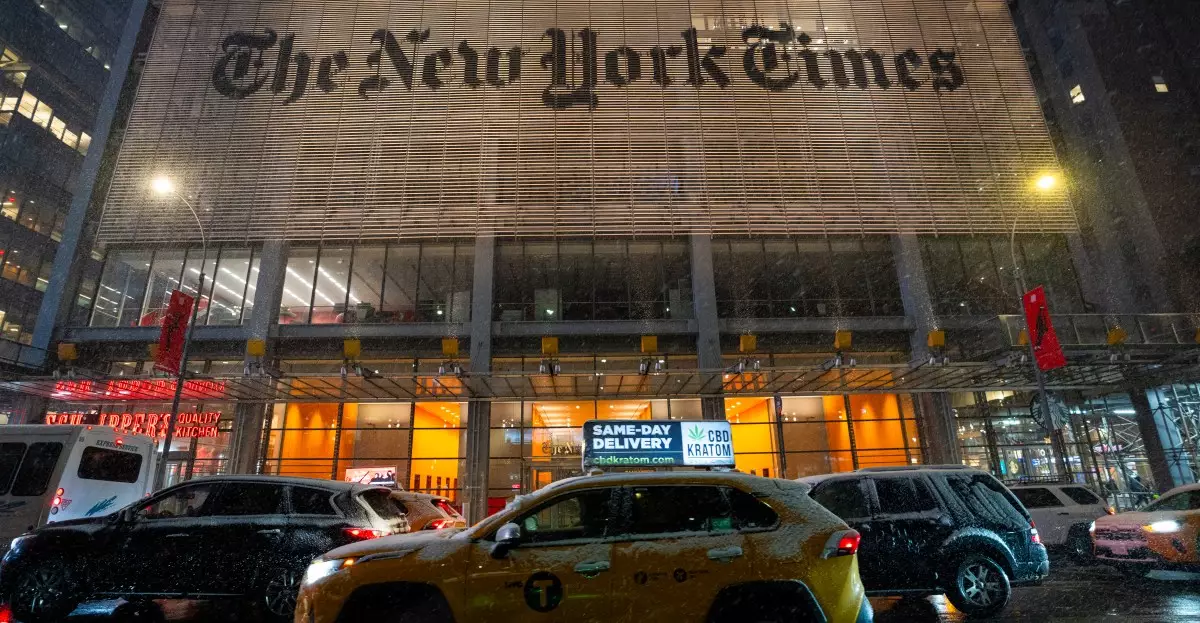As the digital landscape evolves, traditional media organizations are increasingly finding themselves at the intersection of technology and journalism. The advent of artificial intelligence (AI) has prompted several news outlets, including industry giants like The New York Times, to explore innovative ways to enhance their reporting processes. However, this integration raises essential ethical questions and operational challenges that must be carefully navigated. As AI tools become commonplace for tasks such as editing and content generation, it is imperative to scrutinize the implications these technologies pose for the integrity of journalism.
Recent reports indicate that The New York Times has taken concrete steps to usher AI into its editorial workflow, encouraging its staff to leverage these tools in various capacities, such as suggesting edits, crafting headlines, and even drafting interview questions. This move reflects a broader trend among media organizations looking to boost efficiency while maintaining the high standards expected of quality journalism. However, this reliance on AI to perform crucial editorial tasks raises concerns about the dilution of journalistic integrity and the possible erosion of editorial judgment.
While AI can streamline mundane tasks—eliminating the need for human oversight in areas like grammar and syntax—the potential for overreliance remains a pressing concern. The NYT has outlined specific guidelines aimed at utilizing AI without compromising its editorial voice. Yet, the fundamental question persists: does automation undermine the essence of journalistic inquiry and the authenticity of reporting? Journalistic expertise is often derived from nuanced understanding and human judgment, qualities that AI currently lacks.
Guidelines and Restrictions for AI Use
The implementation of AI tools at The New York Times is not without restrictions. Internal memos clarify that while AI can assist in tasks like generating summaries or promotional material, it should never be used to extensively draft articles or manipulate existing content significantly. Journalists are reminded of their responsibility to maintain factual integrity, with AI tools required to be subject to the same rigorous standards as any other editorial process.
Nevertheless, questions arise about the effectiveness of these guidelines. In a fast-paced newsroom, where deadlines loom and the pressure to produce content is high, will journalists truly enforce these restrictions, or will convenience facilitate breaches of protocol? The very nature of urgent news demands could lead to situations where AI-generated content passes through inappropriately unchecked, further diluting the quality that audiences expect from reputable publications.
To support the integration of AI, The New York Times has initiated staff training programs aimed at ensuring employees are equipped to use these tools responsibly. However, the efficacy of such training remains uncertain, particularly when many journalists may lack the technical background necessary to fully understand the implications of AI utilization. Additionally, the speed with which new technologies evolve poses a substantial challenge; training programs could quickly become outdated, leaving journalists and editorial staff unprepared for the next wave of AI advancements.
The adoption of AI in newsrooms isn’t exclusive to The New York Times; other media organizations have also begun integrating these tools at varying degrees. From simple spelling checks to complex article generation, the industry is rapidly redefining the boundaries of automated journalism. But will this widespread adoption lead to a homogenization of news narratives? If numerous outlets deploy similar AI technologies, customized with the same algorithms, the unique voice of different publications may become increasingly indistinguishable.
The Ethical Dilemma
As The New York Times navigates the complexities of integrating AI into its newsroom—especially in light of ongoing legal battles with companies like OpenAI and Microsoft over content use—the ethical implications can be overwhelming. The core role of journalism is to inform and educate the public with accuracy and integrity. The involvement of AI in reporting complicates this mission, blurring the lines between human oversight and machine-generated content.
If news organizations prioritize efficiency over accountability, the very credibility they are built upon might be at risk. As AI continues to evolve, the responsibility lies with human journalists to ensure that AI serves as a supplementary tool rather than a replacement. The challenge will be to embrace technological advancements while maintaining the rigorous standards necessary for responsible journalism.
The integration of AI into journalism embodies a double-edged sword. On one hand, it offers potential efficiencies and innovations that can reshape the industry. On the other, it poses a significant risk to the foundational principles of truth and reliability that define journalism. As news organizations like The New York Times venture into this new territory, maintaining an unwavering commitment to editorial integrity must remain paramount. The balance between leveraging technology to enhance reporting and preserving the human touch—essential for discerning truth—will ultimately determine the future of the profession.

